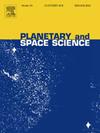Low temperature fluorescence excitation and emission spectra of molecules relevant to Mars: Chlorobenzene, benzoic acid, phthalic acid, mellitic acid, and benzene in water ice solutions at temperatures between 78 K and 273 K
IF 1.7
4区 物理与天体物理
Q3 ASTRONOMY & ASTROPHYSICS
引用次数: 0
Abstract
The discovery of chlorobenzene detected in soil samples obtained in Mars has been the subject of several interpretations. The original sample was subjected to pyrolysis before the gas chromatography-mass spectrometry (GC-MS) separation and identification with the Sample Analysis at Mars (SAM) instrument on the Curiosity rover. It is believed that chlorobenzene detected at concentrations above the background level of the instrument was a product of other organic molecules reacting with perchlorates of the Martian soil. Mars surface temperatures may reach a high of about 293 K at noon, at the equator, and a low of about 120 K at the poles. In this paper, characteristic fluorescence excitation and emission spectra are presented for chlorobenzene and the suggested precursor molecules: benzoic acid, phthalic acid, and mellitic acid in transparent hexagonal water ice solutions at temperatures between 273 K and 78 K. In addition, the liquid solution spectra at 292 K. Spectra of benzene in water ice solutions have also been included. The experimental results presented in this paper are to be compared with fluorescence experiments of Mars missions that will explore the polar regions and other regions where water ice is expected to be found. Limits of detection at part per billion by mass (ng/g) concentrations at room temperature are discussed based on our results and the literature. The application of fluorescence for low temperature studies of Mars samples is also discussed with a proposed miniature instrument with a laser source to increase the sensitivity of the detection and could be used for solid or liquid samples.

与火星相关的分子:氯苯、苯甲酸、邻苯二甲酸、苯乙烯酸和苯在78 ~ 273 K的水冰溶液中的低温荧光激发和发射光谱
在火星获得的土壤样本中检测到氯苯的发现一直是几种解释的主题。将原始样品进行热解处理,然后用好奇号火星车上的样品分析(SAM)仪器进行气相色谱-质谱(GC-MS)分离鉴定。据信,仪器检测到的氯苯浓度高于背景水平,是其他有机分子与火星土壤的高氯酸盐反应的产物。火星表面的温度在正午时分在赤道最高可达293k,在两极最低可达120k。本文研究了氯苯及其前体分子苯甲酸、邻苯二甲酸和苯乙烯酸在273 ~ 78 K的透明六方水冰溶液中的特征荧光激发和发射光谱。此外,液相光谱在292k。苯在水冰溶液中的光谱也包括在内。本文中提出的实验结果将与火星探测任务的荧光实验进行比较,这些任务将探索极地和其他可能发现水冰的地区。根据我们的结果和文献讨论了室温下十亿分之一质量(ng/g)浓度的检测限。本文还讨论了荧光在火星样品低温研究中的应用,并提出了一种带有激光源的微型仪器,以提高探测的灵敏度,并可用于固体或液体样品。
本文章由计算机程序翻译,如有差异,请以英文原文为准。
求助全文
约1分钟内获得全文
求助全文
来源期刊

Planetary and Space Science
地学天文-天文与天体物理
CiteScore
5.40
自引率
4.20%
发文量
126
审稿时长
15 weeks
期刊介绍:
Planetary and Space Science publishes original articles as well as short communications (letters). Ground-based and space-borne instrumentation and laboratory simulation of solar system processes are included. The following fields of planetary and solar system research are covered:
• Celestial mechanics, including dynamical evolution of the solar system, gravitational captures and resonances, relativistic effects, tracking and dynamics
• Cosmochemistry and origin, including all aspects of the formation and initial physical and chemical evolution of the solar system
• Terrestrial planets and satellites, including the physics of the interiors, geology and morphology of the surfaces, tectonics, mineralogy and dating
• Outer planets and satellites, including formation and evolution, remote sensing at all wavelengths and in situ measurements
• Planetary atmospheres, including formation and evolution, circulation and meteorology, boundary layers, remote sensing and laboratory simulation
• Planetary magnetospheres and ionospheres, including origin of magnetic fields, magnetospheric plasma and radiation belts, and their interaction with the sun, the solar wind and satellites
• Small bodies, dust and rings, including asteroids, comets and zodiacal light and their interaction with the solar radiation and the solar wind
• Exobiology, including origin of life, detection of planetary ecosystems and pre-biological phenomena in the solar system and laboratory simulations
• Extrasolar systems, including the detection and/or the detectability of exoplanets and planetary systems, their formation and evolution, the physical and chemical properties of the exoplanets
• History of planetary and space research
 求助内容:
求助内容: 应助结果提醒方式:
应助结果提醒方式:


